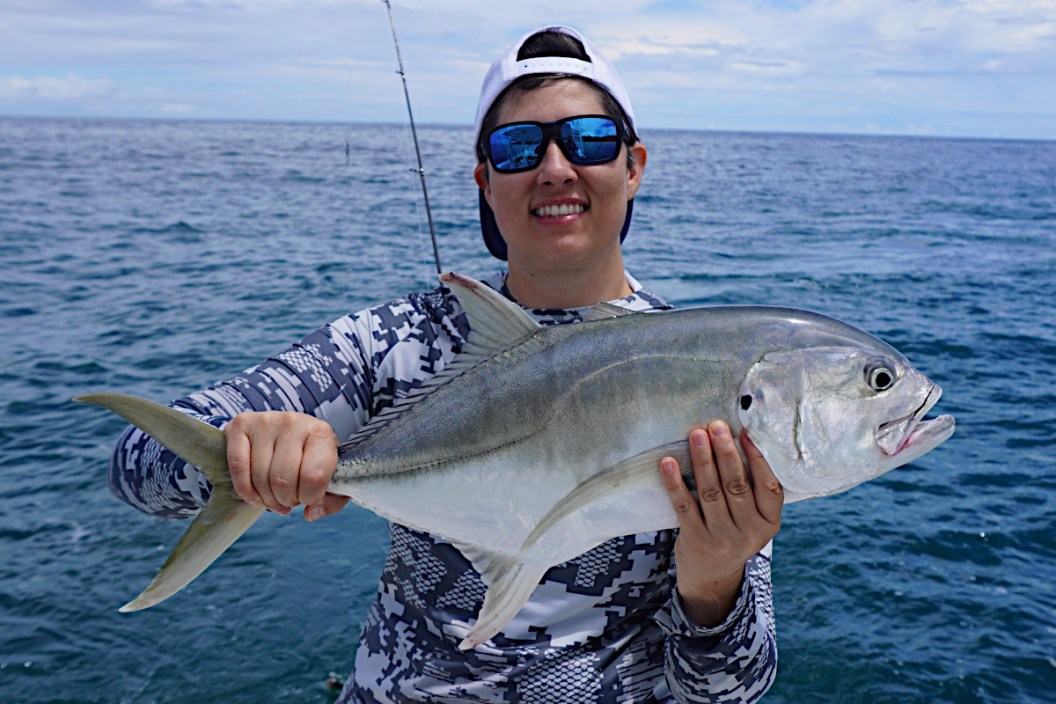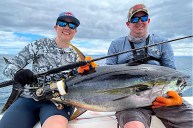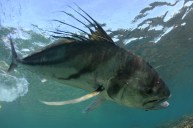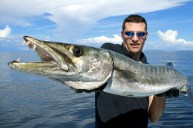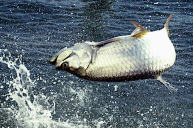The rod creaked, groaned, and line occasionally ripped out of the reel as the fish made run after run, trying to get away. The gamefish on the other end wasn't giant (it was around 20 pounds), but you'd never know it from how it fought. Again and again, it tried to run deeper into the beautiful tropical waters off the coast of Costa Rica. Fortunately, I used one of PENN fishing's newest rods and high gear ratio saltwater spinning reels. After about seven or eight minutes of fighting, the fish finally wore itself out and I was able to get it boat side where the deckhand grabbed it by the tail and swung it aboard. I had just caught a Pacific Jack Crevalle, or Crevalle Jack, depending on what part of the world you're in. It's one of the most common saltwater gamefish one can encounter while inshore fishing.
Jacks are commonly found in coastal waters and estuaries all over the planet and are quite popular with anglers for their aggressive tendencies and hard-nosed runs. They are also a schooling fish, which is great news for anglers. Because where you find one, you're likely to find others just waiting to be caught. Today we'll take a closer look at this species and answer some of the Internet's burning questions about this fascinating fish species.
The Range and Habits of Jack Crevalle

Jordan Jennings
Technically there are a few varieties of this saltwater fish. Today we're focused on the variants found in the Pacific and Atlantic Oceans, respectively. The Pacific variant goes by the scientific name Caranx caninus. It is distributed from California all the way down the Pacific coast through Mexico, and Central America to parts of South America on the coast of Peru. Some populations have also been found hanging on offshore islands like the Galapagos.
The Atlantic species Caranx hippos is the more widely known variety since it ranges as far north as Canadian waters down the entire Atlantic coast of the United States throughout the Gulf of Mexico and the entirety of the Caribbean. You can catch them from all coastlines of Florida. That fact alone puts it on more people's radars since more charters focus on catching them. The Atlantic Ocean Jacks range much further south down the coast of South America, down to Uruguay. They are also found along the western coast of Africa and even more inland in the Mediterranean.
The two subspecies do look nearly identical. Colorations vary from a silver, to a blue green, or even golden coloration. Both variants have two distinctive black spots that make them easy to identify. One is at the base of the pectoral fins, while the other is at the back of the gill cover. They're a bit unique in that the anal and dorsal fins are nearly identical. One thing you'll notice when handling these fish is how they are seemingly built of pure muscle. They remind us of tuna and trevally in that regard. These fish are built for pure speed and power, which is why they are such fierce fighters.
This species lives mostly inshore, although they can be found on offshore structures from time to time. That's mostly where the juvenile fish live until they grow larger. The cool thing about this species is you can sometimes target them hanging in deeper water on shipwrecks miles from shore and in highly shallow flats. They are hardy and can regularly be found in lagoons and freshwater river estuaries easily reached by surf or shore anglers. If you're in a boat, keep a watchful eye out for floating logs, grass, and other debris concentrating on baitfish because more enormous fish love to feed in these locations.
Popular Methods to Target Jack Crevalle

Michelle Gandola
Depending on the size of the fish you hope to catch, there are many ways to catch them. Jacks are extremely aggressive daytime feeders. They will gang up in schools to corner and devour smaller fishes, giving them almost no place to escape. If you can find a feeding school, this can make for some fast action, especially on light tackle. Most anglers prefer a medium-action rod for Jack Crevalle fishing; it will have enough stiffness to leverage the fish without being so stiff that you don't enjoy the fight. Your reel size and line selection will vary depending on your target fish.
While Jacks can grow large, the caught specimens are in the five to ten-pound range. Many anglers prefer a monofilament line in the 10 to 20-pound range. Step it up a bit more to 30 or more if you are expecting larger fish than that. Jacks often frequent areas where other large game fish can be found, so it's not bad to step it up to 50 pounds or more if you expect incidental catches of other species like snook or tarpon. You might also consider using braid if you expect unexpected catches. The reel size you'll need varies on how much of a fight you're looking to get. Most anglers prefer to use 2500 at a minimum. Anything less than that will probably be a tough fight unless it's a tiny Jack.
As far as live bait goes, just about any baitfish will do the trick. Most anglers prefer mullets, but just about any small fish will do the job. Jacks like to corner these small fish on offshore reefs or in the shallows of a beach and then pick them off one by one. In more open waters, it's not uncommon for them to box smaller fish into tight bait balls and then pick them off. Baitfish are the usual live bait of choice but don't overlook the use of crustaceans like shrimp.
Aside from living bait, the most popular method of targeting Jacks is to jig for them with large bucktails or spoons ripped through the water quickly. However, if you want the ultimate thrill in Jack fishing, go with a sizeable topwater popper. It's the method to use when you see the Jacks boiling and spooking baitfish on the surface. The only downside to using artificial lures is that Jacks demand an aggressive retrieve. You've got to rip the lure across the water surface if you want them to hit it. They have a short attention span otherwise. And when you're using a large surface popper on heavy tackle, it gets rather tiring quickly to fish are lure like that for an extended period.
However, when you hook up with a big Jack that has just blasted your topwater popper on the surface, there is no more incredible feeling in the world. If you're looking for a thrilling fish to catch inshore, the Jack is a great one to target.
Is Jack Crevalle a Good Eating Fish?
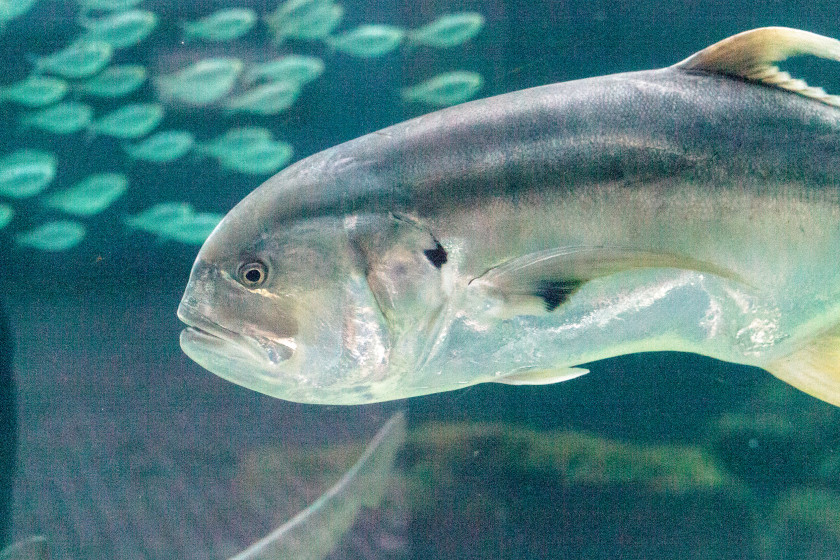
LagunaticPhoto via Getty Images
This is the one downside to Jack Crevalle. They aren't exactly known as a delicacy. Some people downright hate them because there are usually much better options for the dinner table hanging out in the same area. Of course, the flip side is that there's always going to be someone who claims the fish is delicious and that others don't know how to prepare it. The overwhelming opinion is that Jack Crevalle doesn't produce tasty meals, which is a shame, given how common they are.
We have heard that if you want to eat one, you should focus on smaller specimens. It seems they are a little like wild hogs in that the smaller ones are better for eating. The more giant Jacks tend to have dark meat that isn't as tasty or as flavorful. That's why Jack has earned a reputation as a sport fishing species, first and foremost.
How Big Do Jack Crevalle Get?
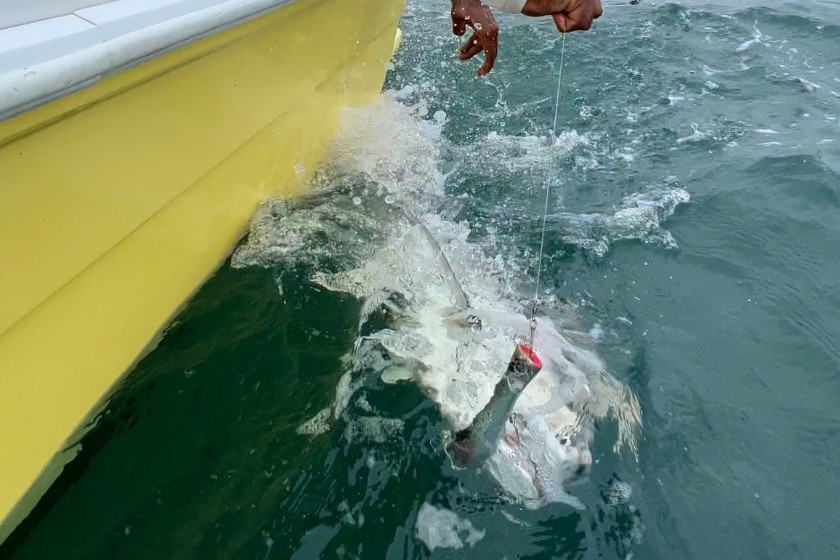
Jordan Jennings
As we already mentioned, most Jacks tend to fall in the 5-10-pound range at most, but the potential is there for them to grow much larger. The Pacific subspecies do not grow as large as the Atlantic ones. The all-tackle world record for the Pacific variant is 39 pounds and was caught off Costa Rica in 1997. Costa Rica and Mexico hold the most line class records for the Pacific subspecies.
The western Atlantic seems to hold more giant Jacks than the east. The all-tackle world record is a 66-pound, 2-ounce beast caught off Angola in 2010. However, Florida has proven to be the hot spot for anyone pursuing line class or tippet records, especially around Key West, Pensacola, and Jupiter. This is likely because Florida is a much more affordable year-round fishery for anglers from the U.S. than any other location worldwide.
Whatever the case, the Jack Crevalle is a fish to pursue if you are looking for an easy-to-find fighter that will test all your fish fighting skills this year.
For more outdoor content from Travis Smola, follow him on Twitter and Instagram. Check out his Geocaching and Outdoors with Travis YouTube channels for original videos.
